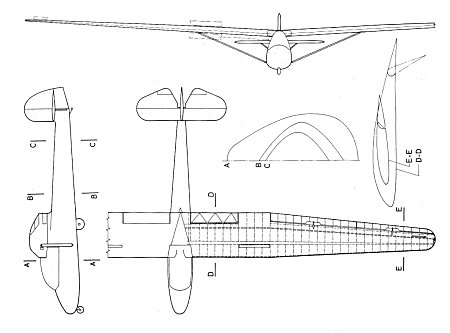HUNGARIAN
GLIDERS
1933-2000

Short history:
In 1948 the Hungarian National Flying Association (OMRE) invited tenders for a two-seater basic training glider. Hugó Nagy and Tibor Bánsági had sent in a glider design, which became the runner-up of the tender. In 1950 the construction of a modified version of this glider, having christened "Bene" by its designer, Hugó Nagy, commenced at the Central Workshop of the Hungarian Aeronautical Association at Dunakeszi. ("Bene" was the nickname of the designer of the M-30 Fergeteg, Lajos Benicky.) The glider first flew at August, 1952. Unfortunately the capabilities of the glider were not thoroughly investigated as in 1951 the serial production of the Z-03 Ifjúság had been decided. The Bene was discarded in 1954.
The main purpose of Bene's designer was to develop a training glider with handling characteristics similar to the basic powered trainer used at that time, the Bücker Bü-131, as glider training was solely considered as preparation for flying power aircraft. The glider was certified for winch launching and aerotowing, and cloudflying was permitted as well.
Structure: Wooden wing, combined steel-tube and wooden fuselage
Wing:
The two-part wing of the high-winged, glider had a central 6 m span rectangular planform. The airfoil section of this part was Gö 549 and no washout was applied. The outer parts of the wing were tapered and the airfoil section gradually turned into Gö 676 at the wingtips. The strutted wing had one main spar and an auxiliary spar at the 70 % of the chord. The whole wing was covered by plywood. The main load-bearing element of the wing was the box shaped between the main and the secondary spars. The two half wings were connected to the fuselage by ball-and-socket joints. The secondary spar's connection was adjustable vertically and turnable around the vertical axis.
The Frise-type ailerons were divided spanwise. The movement of the inner and outer parts of the ailerons had a differential ratio of 2:1. The turn of the glider was assisted by small spoilers opening up on the upper surface of the wing near to the wingtips inside of the turn. Göppingen type airbrakes and flaps with spans of 1,5 m on both sides were fitted to assist landings.
.jpg)
Fuselage:
The front part of the relatively long fuselage was a welded steel-tube structure with fabric covering spanned on shape-forming ribs. The landing gear consisted of a nose wheel, a main wheel located behind the c.g. and a small tail skid. Both wheels were fixed. The fuselage behind the wing had a wooden structure connected to the front part by four ball-and-socket joints. The back seat was raised a bit to give opportunity for the instructor to see the instruments in front of the student. For high winch launches hooks for Y-wire were fitted on both sides of the fuselage.
Tail unit:
The tail unit had a traditional arrangement. Identical airfoil sections were used on the vertical and the horizontal surfaces.

| Dimensions: |
| Wing: |
| Span, m: |
17 |
| Area, m2: |
21,1 |
| Aspect ratio: |
13,7 |
| Chord (root), m: |
1,5 |
| Chord (tip), m: |
0,7 |
| Airfoil (root), m: |
Gö 549 mod. |
| Airfoil (mid-span), m: |
Gö 549 mod. |
| Airfoil (tip), m: |
Gö 676 |
| Dihedral, degree: |
3 |
| Sweep, degree: |
0 |
| Washout: |
Aerodynamic and geometric of -6 degree |
| Aileron: |
| Span, m: |
5,47 |
| Mean chord, m: |
0,64 |
| Total area, m2: |
3,98 |
| Balancing: |
None |
| Flap: |
| Type: |
Plain |
| Area, m2: |
2,08 |
| Relative length, %: |
0,187 |
| Movement (+/-), degree: |
?/0 |
| Airbrakes: |
| Type: |
Göppingen |
| Position (upside/downside): |
u/d |
| Total area, m2: |
0,56 |
| Position, % of chord: |
0,284 |
| Horizontal stabilizer: |
| Span, m: |
3,0 |
| Area, m2: |
2,46 |
| Elevator: |
| Span, m: |
3,0 |
| Area, m2: |
1,23 |
| Airfoil: |
Symmetrical |
| Balancing: |
Aerodynamic and inner mass |
| Trim: |
Yes |
| Vertical stabilizer and rudder: |
| Total area, m2: |
1,228 |
| Rudder area, m2: |
0,683 |
| Balancing: |
Aerodynamic and mass |
| Fuselage: |
| Length, m: |
7,45 |
| Width, m: |
0,82 |
| Height: |
1,3 |
| Cross section, m2: |
0,75 |
| Landing gear: |
| Type: |
Fixed nose and main wheel |
| Wheel diameter, m: |
Nose: 0,26, main: 0,42 |
| Masses: |
| Wing, kg: |
140 |
| Fuselage, kg: |
90 |
| Tail unit, kg: |
14 |
| Empty glider, kg: |
244 |
| Gross, kg: |
420 |
| Ballast, kg: |
None |
| Wing loading, kg/m2: |
19,9 |
| Speeds: |
| VNE, km/h: |
220 |
| Max. speed with open airbrakes, km/h: |
220 |
| Max. aerotow speed, km/h: |
120 |
| Max. winch speed, km/h: |
80 |
| Max. speed in rough air, km/h: |
120 |
| Stall speed, km/h: |
? |
| Performance: |
| Min. sink, m/s (at gliding speed, km/h): |
0,95/65 |
| Best L/D (at gliding speed, km/h): |
20,5/72 |
| Start methods: |
Winch, Aerotow |

Origin of data and 3-view drawing:
Jereb Gábor: Magyar vitorlázó repülőgépek, Műszaki Könyvkiadó, 1988, Budapest
(Gábor JEREB: Hungarian Gliders, Technical Publishing House, 1988, Budapest)
Gábor FEKECS E-mail: fekecs.gabor@t-online.hu
.jpg)

